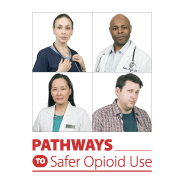Every March we celebrate Patient Safety Awareness Week, a time to raise awareness about the importance of patient safety — and a great opportunity to share strategies that health professionals can use to protect their patients.
Pathways to Safer Opioid Use is an interactive training that ODPHP developed for health care professionals, public health professionals, and students. It includes guidance and strategies for protecting patients managing chronic pain from opioid-related adverse drug events. The strategies outlined in the training are based on recommendations from the National Action Plan for Adverse Drug Event Prevention (ADE Action Plan).
Since 2015, ODPHP has partnered with the American Public Health Association (APHA) to promote Pathways and offer continuing education credit to users. Additionally, APHA is currently leading an evaluation of the training. ODPHP plans to use the evaluation results to understand what’s working about Pathways — and to identify ways to improve it.
In honor of Patient Safety Awareness Week, ODPHP and APHA hosted a Twitter interview about the training and evaluation efforts. The interview covered topics like Pathway’s development, the evaluation process, and why the strategies in the training are so important for health professionals today.
Missed the chat? No problem! Check out a recap of the conversation below. And if you’ve taken the Pathways training and are interested in sharing your feedback, please register for the evaluation.
Understanding Pathways
Q1: What is the Pathways to Safer Opioid Use training and what makes it different from other opioid safety trainings for health professionals? #P2SaferOpioidUse
— APHA (@PublicHealth), Mar 13, 2018
A1: Pathways is an online training for health professionals that promotes the appropriate, safe, and effective use of #opioids to manage #ChronicPain. #P2SaferOpioidUse #PSAW18
— ODPHP (@HHSPrevention), March 13, 2018
A1: The format of the training is what makes it unique. Users experience learning through an interactive, video-based platform - you can even choose different roles based on your profession! #P2SaferOpioidUse #PSAW18
— ODPHP (@HHSPrevention), March 13, 2018
Developing Pathways
Q2: How and why did ODPHP develop Pathways to Safer Opioid Use? #P2SaferOpioidUse
— APHA (@PublicHealth), Mar 13, 2018
A2: The training is based on opioid-related recommendations from the National Action Plan for Adverse Drug Event Prevention: https://health.gov/hcq/ade-action-plan.asp… #P2SaferOpioidUse #PSAW18
— ODPHP (@HHSPrevention), March 13, 2018
A2: The Pathways training helps us put recommendations from the plan into practice - so health professionals have the tools they need to reduce adverse drug events. #P2SaferOpioidUse #PSAW18
— ODPHP (@HHSPrevention), March 13, 2018
A2: We also did an environmental scan in 2014 and identified a need for trainings that focus on shared decision-making and use a multidisciplinary approach to pain management. #P2SaferOpioidUse #PSAW18
— ODPHP (@HHSPrevention), March 13, 2018
A2: Pathways was developed with an emphasis on #HealthLiteracy, which helps improve communication and understanding between health professionals and patients. #P2SaferOpioidUse #PSAW18
— ODPHP (@HHSPrevention), March 13, 2018
Key Learning Objectives
Q3: Who will benefit from taking the Pathways training? What skills will users learn? #P2SaferOpioidUse
— APHA (@PublicHealth), Mar 13, 2018
A3: The training is intended for physicians, nurses, pharmacists, public health professionals, and students in health-related fields - but anyone with an interest in #opioid safety can take it! #P2SaferOpioidUse #PSAW18
— ODPHP (@HHSPrevention), March 13, 2018
A3: Users can learn important #HealthLiteracy strategies to aid patient understanding, as well as ways to identify risk factors for opioid misuse. #P2SaferOpioidUse #PSAW18
— ODPHP (@HHSPrevention), March 13, 2018
A3: This training models a team-based approach for #ChronicPain treatment - and demonstrates how to use principles from the Health Literate Care Model and the biopsychosocial model of chronic pain management. #P2SaferOpioidUse #PSAW18
— ODPHP (@HHSPrevention), March 13, 2018
A3: AND medical professionals and pharmacists who take the training can earn free #CMEcredit and #CPEcredit! #P2SaferOpioidUse #PSAW18
— ODPHP (@HHSPrevention), March 13, 2018
APHA is happy to be offering CME credits for the training. #P2SaferOpioidUse
— APHA (@PublicHealth), Mar 13, 2018
Evaluating Pathways
Q4: Why is it important to have participants evaluate the training? What is the evaluation process? #P2SaferOpioidUse
— APHA (@PublicHealth), Mar 13, 2018
A4: We're working with @PublicHealth to do an evaluation of the Pathways training so we can better meet the needs of health professionals like you. #P2SaferOpioidUse #PSAW18
— ODPHP (@HHSPrevention), March 13, 2018
A4: Evaluation helps us identify behaviors that health professionals are already applying in daily practice so we can better tailor the training. #P2SaferOpioidUse #PSAW18
— ODPHP (@HHSPrevention), March 13, 2018
A4: This evaluation will also help us gather information about the obstacles health professionals face when working with patients dealing with #ChronicPain. #P2SaferOpioidUse #PSAW18
— ODPHP (@HHSPrevention), March 13, 2018
A4: Our goal is to identify ways we can improve Pathways - and to highlight the parts that are already working well. Read more on our blog: https://health.gov/news/blog/2018/01/evaluating-pathways-safer-opioid-use-online-training… #P2SaferOpioidUse #PSAW18
— ODPHP (@HHSPrevention), March 13, 2018
We want to hear from you! Participate in the evaluation. #P2SaferOpioidUse
— APHA (@PublicHealth), Mar 13, 2018
A4: Participating in the evaluation is completely voluntary. Participants complete 2 15-minute surveys and a 30-minute interview. #P2SaferOpioidUse #PSAW18
— ODPHP (@HHSPrevention), March 13, 201
The Importance of Pathways and Other Opioid-Related Trainings
Q5: Why is opioid safety such an important training topic for health professionals right now? #P2SaferOpioidUse
— APHA (@PublicHealth), Mar 13, 2018
A5: #Opioid misuse has been increasing over the last 2 decades and was declared a #PublicHealth emergency in 2017. #P2SaferOpioidUse #PSAW18
— ODPHP (@HHSPrevention), March 13, 2018
A5: Prescription opioids are highly addictive - and 116 people die each day in the U.S. from opioid-related overdoses. #P2SaferOpioidUse #PSAW18
— ODPHP (@HHSPrevention), March 13, 2018
A5: Our goal is to give health professionals the tools they need to protect patients from #opioid-related adverse drug events. #P2SaferOpioidUse #PSAW18
— ODPHP (@HHSPrevention), March 13, 2018




